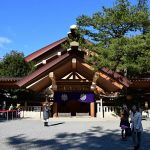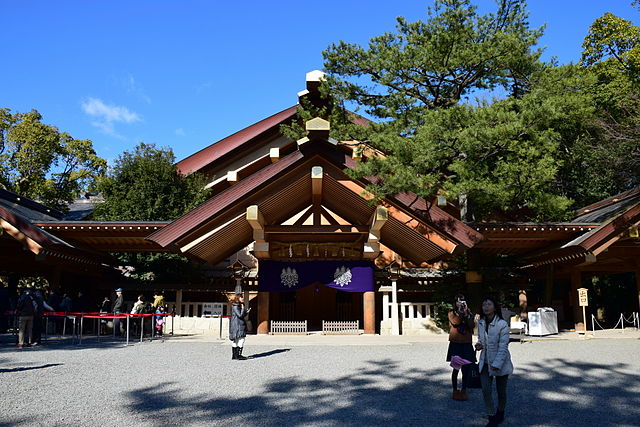Dec 26, 2024
Hatsumode in Nagoya – Shrines to Visit for New Years
Oshogatsu, or New Year, is the most important holiday in Japan. Businesses shut down from January 1 to January 3, and families gather to spend time together. During the New Year, most places around Japan look like ghost towns, as children fly kites, play card games or count their otoshidama [cash presents from relatives]. It is a time to relax, and those who enjoy a tipple may do so from breakfast to sundown and, so that no one has to cook, pick from pre-made boxes of food called osechi that will be eaten cold throughout the holiday. At some point over the coming days, most people all over the country will enjoy a visit to the shrine to pray for prosperity, purchase good luck charms, and write their hopes and dreams on wooden plaques to hang for good fortune in the new year.
Here are a few impressive shrines for you to see in the New Year:
Atsuta Shrine Hatsumode
 Atsuta Jingu was founded about 1900 years ago, when the sacred sword Kusanagi-no-tsurugi, one of the Imperial symbols, was enshrined. The shrine has a peaceful feel (although not in the New Year period when people line the paths to pray) and boasts many old and beautiful sacred trees. Going there by train is preferable to by car as there is not much parking. The shrine is accessible via Jingu Nishi Station on the Meijo (purple) subway line or Jingu-Mae on the Meitetsu line.
Atsuta Jingu was founded about 1900 years ago, when the sacred sword Kusanagi-no-tsurugi, one of the Imperial symbols, was enshrined. The shrine has a peaceful feel (although not in the New Year period when people line the paths to pray) and boasts many old and beautiful sacred trees. Going there by train is preferable to by car as there is not much parking. The shrine is accessible via Jingu Nishi Station on the Meijo (purple) subway line or Jingu-Mae on the Meitetsu line.
Atsuta Shrine in Nagoya (JIS Article)
Atsuta Shrine
Atsutajingu-Kyu-Cho (Shrine Office) 1-1-1 Jingu, Atsuta-Ku, Nagoya, Japan 456-8585 – Google Map
052-671-4151
www.atsutajingu.or.jp
Tado Shrine Hatsumode
 This shrine in the countryside of Kuwana was established over 1500 years ago. The shrine’s symbol is the horse, as reflected in the festival that happens every May, in which horseback riders wearing samurai armor jump horses over a small cliff. This horse festival is its most famous activity, but it is still a popular destination for New Years’ as well, which wouldn’t be overly crowded if you wanted to avoid the crowds.
This shrine in the countryside of Kuwana was established over 1500 years ago. The shrine’s symbol is the horse, as reflected in the festival that happens every May, in which horseback riders wearing samurai armor jump horses over a small cliff. This horse festival is its most famous activity, but it is still a popular destination for New Years’ as well, which wouldn’t be overly crowded if you wanted to avoid the crowds.
Be prepared to climb stairs, though, as there are many. Traveling there by car is preferable, although the nearest train station would be Kuwana on the JR or Kintetsu Line. This shrine is located between Nagoya and Ise – not that I’m suggesting you try going to all three shrines listed here in one day.
Tado Shrine
1681 Tado Tado-Cho Kuwana-shi Mie-ken 511-0106 – Google Map
0594-48-2037
en.wikipedia.org/wiki/Tado_Shrine
Ise Shrine Hatsumode
 One of Japan’s most important shrines and cultural assets, Ise Shrine, known as “Jingu,” has a history of about 2000 years. Ise was established to worship the goddess Amaterasu-omikami, whose tears are said to have made up Japan’s many islands.
One of Japan’s most important shrines and cultural assets, Ise Shrine, known as “Jingu,” has a history of about 2000 years. Ise was established to worship the goddess Amaterasu-omikami, whose tears are said to have made up Japan’s many islands.
The inner sanctum (Naiku) is purportedly the home of the sacred mirror, meaning that two of the three sacred artifacts (the mirror at Ise and the sword at Atsuta) are close to home for those living in Nagoya. You can’t see the sacred artifact itself. Still, you can feel the shrine’s spirituality in the holy forest, which was traditionally harvested for the cypress used to fortify the shrine in ceremonies.
Read a full JIS article about Ise Shrine by clicking here.
Ise Shrine
1 Ujitachi-Cho, Ise, Mie 516-0023, Japan – Google Map
Tel: 0596-24-1111
www.isejingu.or.jp/en
Osu Kannon Hatsumode
 Osu Kannon Temple was moved to its current location by the very late and very great Tokugawa Ieyasu in 1612. The main temple on the site today was reconstructed in 1970. Osu Kannon’s library contains over 15,000 Buddhist texts, including the oldest known hand-written copy of the “Kojiki,” a historical chronicle of early Japanese history.
Osu Kannon Temple was moved to its current location by the very late and very great Tokugawa Ieyasu in 1612. The main temple on the site today was reconstructed in 1970. Osu Kannon’s library contains over 15,000 Buddhist texts, including the oldest known hand-written copy of the “Kojiki,” a historical chronicle of early Japanese history.
This temple is probably the easiest to visit on our list, but that makes it no less worth the trip. Ringing the bell will require at least an hour in line, and plenty of food stalls are available; this is a popular place, even if less so than Ise or Atsuta Shrines.
Osu Kannon
2 Chome-21-47 Osu Naka Ward, Nagoya, Aichi Prefecture 460-0011 – Google Map
052 231 6525
https://en.wikipedia.org/wiki/Ōsu_Kannon
Toyokawa Inari Shrine
 Established by the monk Tokai Geki in 1441, Toyokawa Inari is not only a Sodo sect Buddhist temple, but also a Shinto place of worship. One of Japan’s three main Inari shrines, Toyokawa Inari covers a sprawling 1,272 hectares, the entrance to which features a huge 4.5-meter-high door crafted from a single slab of wood, and you are welcomed by both a Shinto torii gate and a pair of fierce Buddhist Nio temple guardians.
Established by the monk Tokai Geki in 1441, Toyokawa Inari is not only a Sodo sect Buddhist temple, but also a Shinto place of worship. One of Japan’s three main Inari shrines, Toyokawa Inari covers a sprawling 1,272 hectares, the entrance to which features a huge 4.5-meter-high door crafted from a single slab of wood, and you are welcomed by both a Shinto torii gate and a pair of fierce Buddhist Nio temple guardians.
The street leading up to the main gates has numerous restaurants, cafes and souvenirs stores, while there will be plenty of additional stalls and street food to serve the multitude of visitors at this holy time. and makes for an enjoyable stroll.
You can read all about the shrine in another one of our articles here.
Toyokawa Inari Shrine
1 Toyokawacho, Toyokawa, Aichi 442-0033 (map)
0827230820
https://www.toyokawainari.jp/
Image: By Bariston (Own work) [CC BY-SA 4.0], via Wikimedia Commons – Modified
Image: By Ohaguro (User:Ohaguro) [GFDL], via Wikimedia Commons – Modified
Image: By N yotarou (Own work) [CC BY-SA 4.0], via Wikimedia Commons – Modified
Image: by GothPhil via flickr.com (CC BY-SA 2.0) -Modified


About the author